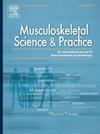Comparisons and analysis of cut-off points of patient-reported and performance-based functions in early stages of knee osteoarthritis: A cross-sectional study
IF 2.2
3区 医学
Q1 REHABILITATION
引用次数: 0
Abstract
Objective
The primary aim was to compare patient-reported and performance-based functions of early stages of knee osteoarthritis (OA) according to radiographic grades. The secondary purpose was to determine the ability of physical function assessments to discriminate the stages.
Methods
Ninety-five symptomatic knee OA patients (median age = 51 [45–58] years; 65.3 % women) were classified as pre-radiographic (grade 0, n = 19), early (grade 1, n = 38), and mild (grade 2, n = 38) according to the Kellgren-Lawrence. The Knee Injury and Osteoarthritis Outcome Score (KOOS), Visual Analog Scale (VAS), 6-Minute Walk Test (6-MWT), Stair Climb Test (SCT), and Single-Limb Mini Squat Test (SLMS) were used for evaluations. Statistical analyses were performed with One-Way ANOVA, Kruskal Wallis, and ROC analyses.
Results
Pre-radiographic, early, and mild knee OA showed no differences in VAS and KOOS-pain, daily living activities, and quality of life (p > 0.05). The mild group had lower KOOS-sports and recreational activity scores than the pre-radiographic group, had the shortest 6-MWT distance, longest SCT time, and lowest SLMS repetitions. The early group had fewer SLMS repetitions than the pre-radiographic group. The SLMS Test, SCT and 6-MWT values with the best balance of sensitivity and specificity for discriminating early knee OA were 15 repetitions, 11.75 s and 483 m, respectively (area under the curve: 0.816, 0.753 and 0.798 respectively).
Conclusion
No differences were observed for patient-reported functions except KOOS-sport and recreational activities; however, performance-based physical functions differed between radiographic stages. The cut-off results of the performance-based functions may be useful for clinical screening and follow-ups in early knee OA.
比较和分析早期膝关节骨关节炎患者报告的和基于表现的功能的分界点:一项横断面研究
主要目的是比较患者报告的早期膝关节骨关节炎(OA)的影像学分级和基于表现的功能。第二个目的是确定身体功能评估区分分期的能力。方法95例有症状的膝关节OA患者(中位年龄51[45-58]岁);根据Kellgren-Lawrence, 65.3%的女性)分为放射前(0级,n = 19)、早期(1级,n = 38)和轻度(2级,n = 38)。采用膝关节损伤和骨关节炎结局评分(kos)、视觉模拟量表(VAS)、6分钟步行测试(6-MWT)、爬楼梯测试(SCT)和单肢迷你深蹲测试(SLMS)进行评估。统计分析采用单因素方差分析、Kruskal Wallis分析和ROC分析。结果影像学前、早期和轻度膝关节OA患者在VAS和koos疼痛、日常生活活动和生活质量方面均无差异(p >;0.05)。轻度组的koos -运动和娱乐活动评分低于放射前组,6-MWT距离最短,SCT时间最长,SLMS重复次数最少。早期组SLMS重复次数少于放射前组。SLMS Test、SCT和6-MWT值分别为15次重复、11.75 s和483 m(曲线下面积分别为0.816、0.753和0.798),敏感性和特异性平衡最佳。结论除koos -运动和娱乐活动外,患者报告的功能无显著差异;然而,基于表现的身体机能在不同的x线摄影阶段有所不同。基于性能的功能的截止结果可能对早期膝关节OA的临床筛查和随访有用。
本文章由计算机程序翻译,如有差异,请以英文原文为准。
求助全文
约1分钟内获得全文
求助全文
来源期刊

Musculoskeletal Science and Practice
Health Professions-Physical Therapy, Sports Therapy and Rehabilitation
CiteScore
4.10
自引率
8.70%
发文量
152
审稿时长
48 days
期刊介绍:
Musculoskeletal Science & Practice, international journal of musculoskeletal physiotherapy, is a peer-reviewed international journal (previously Manual Therapy), publishing high quality original research, review and Masterclass articles that contribute to improving the clinical understanding of appropriate care processes for musculoskeletal disorders. The journal publishes articles that influence or add to the body of evidence on diagnostic and therapeutic processes, patient centered care, guidelines for musculoskeletal therapeutics and theoretical models that support developments in assessment, diagnosis, clinical reasoning and interventions.
 求助内容:
求助内容: 应助结果提醒方式:
应助结果提醒方式:


